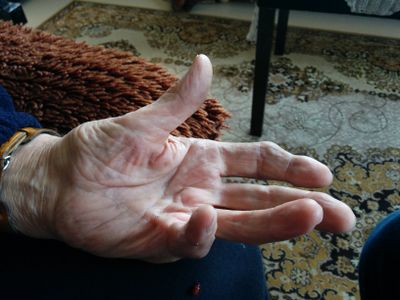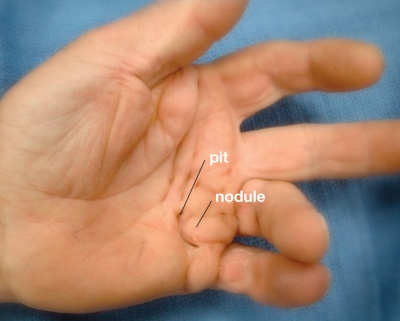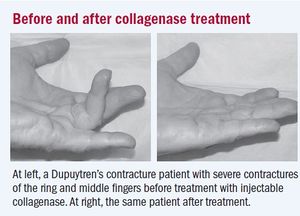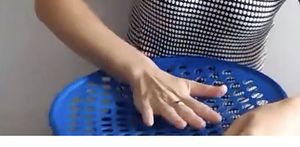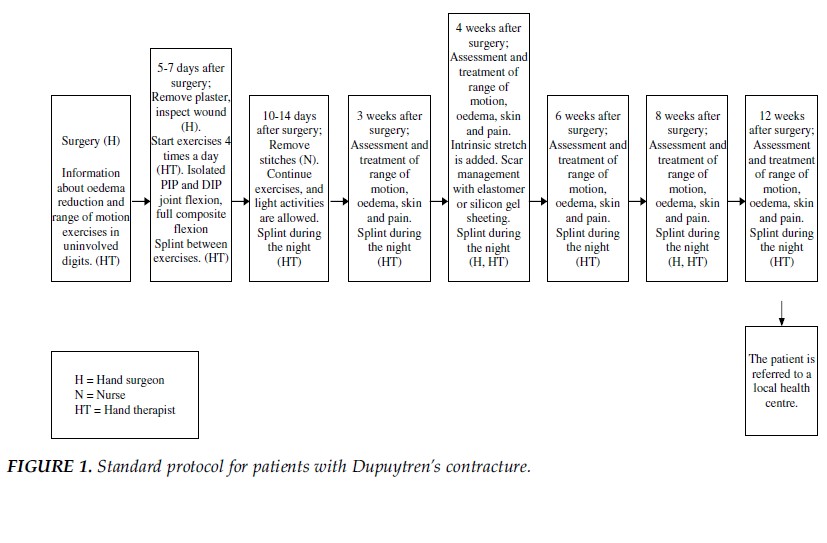Dupuytren’s Contracture: Difference between revisions
No edit summary |
No edit summary |
||
| Line 9: | Line 9: | ||
Dupuytren contracture is a progressive disease of the palmar fascia which results in shortening, thickening and fibrosis of the fascia and aponeurosis of the palm. | Dupuytren contracture is a progressive disease of the palmar fascia which results in shortening, thickening and fibrosis of the fascia and aponeurosis of the palm. | ||
[[Image:Cord.jpg|400x400px|Image 1: Clinical presentation of Dupuytren contracture|right|frameless]]The palmar fascia is continuous with the antebrachial fascia, the deep fascia of the forearm, and the layer of fascia that covers the dorsum of the hand. The palmar fascia is thicker in the center of the palm and fingers where it forms the palmar aponeurosis and digital sheaths, respectively. The palmar aponeurosis covers the soft tissues of the palm and long flexor tendons. As the longitudinal bands of the palmar aponeurosis undergo fibrosis, the metacarpophalangeal and proximal interphalangeal joints get pulled into flexion. The fourth metacarpal is most commonly affected, followed by the fifth, third, and second. Recently, Dupuytren disease has become a more widely adopted term than Dupuytren contracture to name this condition, as the fingers are not always held in a fixed flexion deformity.<ref name="Bayat" /><br> | [[Image:Cord.jpg|400x400px|Image 1: Clinical presentation of Dupuytren contracture|right|frameless]]The palmar fascia is continuous with the antebrachial fascia, the deep fascia of the forearm, and the layer of fascia that covers the dorsum of the hand. The palmar fascia is thicker in the center of the palm and fingers where it forms the palmar aponeurosis and digital sheaths, respectively. The palmar aponeurosis covers the soft tissues of the palm and long flexor tendons. As the longitudinal bands of the palmar aponeurosis undergo fibrosis, the metacarpophalangeal and proximal interphalangeal joints get pulled into flexion. The fourth metacarpal is most commonly affected, followed by the fifth, third, and second. Recently, Dupuytren disease has become a more widely adopted term than Dupuytren contracture to name this condition, as the fingers are not always held in a fixed flexion deformity.<ref name="Bayat">Bayat A. A nonsurgical therapy for Dupuytren disease. Rheumatology. 2010;6:7-8.</ref><br> | ||
Image 1: Clinical presentation of Dupuytren contracture<ref>Dupuytren’s Disease. American Society for Surgery of the Hand Web site. http://www.assh.org/Public/HandConditions/Pages/DupuytrensDisease.aspx. 2010. Accessed March 19, 2011.</ref> | Image 1: Clinical presentation of Dupuytren contracture<ref>Dupuytren’s Disease. American Society for Surgery of the Hand Web site. http://www.assh.org/Public/HandConditions/Pages/DupuytrensDisease.aspx. 2010. Accessed March 19, 2011.</ref> | ||
| Line 47: | Line 47: | ||
== Outcome Measures == | == Outcome Measures == | ||
* [[File:Patient reported outcome measure.jpg|right|frameless|200x200px]]Range of motion measurements of the metacarpophalangeal (MCP), proximal interphalangeal (PIP) and distal interphalangeal (DIP) joints should be recorded ( flexion and extension of these joints, with measurements of passive and active range of motion). Take as a baseline measure and then throughout the treatment process, can help stage the severity of the contractures. | |||
* Measure hand function by tests and measures such as eg Disabilities of the Arm, Shoulder, and Hand Questionnaire ([[DASH Outcome Measure|The DASH]]), or its shorter version The Quick Dash. | |||
== Medical Management == | == Medical Management == | ||
| Line 62: | Line 60: | ||
* Corticosteroid injections may be beneficial for some patients eg those with painful nodules. Steroid injections do not work in all patients and a 50% recurrence has been reported. Corticosteroid injections can lead to fat atrophy, pigmentation change and there is the potential to cause rupture of the tendons. | * Corticosteroid injections may be beneficial for some patients eg those with painful nodules. Steroid injections do not work in all patients and a 50% recurrence has been reported. Corticosteroid injections can lead to fat atrophy, pigmentation change and there is the potential to cause rupture of the tendons. | ||
* Other treatments that have been tried include: tamoxifen; anti-tumor necrosis factor agents; 5 fluorouracil,; miquimod; botulinum toxin. No evidence exists to say any of these treatments are superior or work in everyone. | * Other treatments that have been tried include: tamoxifen; anti-tumor necrosis factor agents; 5 fluorouracil,; miquimod; botulinum toxin. No evidence exists to say any of these treatments are superior or work in everyone. | ||
* Radiation therapy may work during the early phase of the disease only but is also associated with a significant number of complications. | * Radiation therapy may work during the early phase of the disease only but is also associated with a significant number of complications.[[Image:Collagenase Treatment.jpg|Image 6: Before and after collagenase treatment|right|frameless]] | ||
* Needle aponeurotomy is typically reserved for mild contractures. The procedure is minimally invasive and is often performed in an office setting. | * Needle aponeurotomy is typically reserved for mild contractures. The procedure is minimally invasive and is often performed in an office setting. | ||
* Collagenase injections provide a minimally invasive treatment derived from Clostridium Histolyticum. Night extension splinting is maintained for 6 months. Collagenase injections result in a 75% contracture reduction with a 35% recurrence rate. Complications include edema, skin tearing, tendon rupture, complex regional pain syndrome, and pulley rupture. | * Collagenase injections provide a minimally invasive treatment derived from Clostridium Histolyticum. Night extension splinting is maintained for 6 months. Collagenase injections result in a 75% contracture reduction with a 35% recurrence rate. Complications include edema, skin tearing, tendon rupture, complex regional pain syndrome, and pulley rupture.Before and after collagenase treatment image at R <ref name="Harvard University">Harvard University. Nonsurgical approach unlocks contracted fingers. Harvard Women’s Health Watch. 2009:6-7.</ref> | ||
* Surgical fasciectomy can be either limited or radical. The recurrence rate at 1 to 2 years is 30%, 15% at 3 to 5 years, and less than 10% after ten years. | * Surgical fasciectomy can be either limited or radical. The recurrence rate at 1 to 2 years is 30%, 15% at 3 to 5 years, and less than 10% after ten years. | ||
* Total palmar fasciectomy can also be performed but is infrequently used as it requires resection of all palmar and digital fascia, including nondiseased tissue. | * Total palmar fasciectomy can also be performed but is infrequently used as it requires resection of all palmar and digital fascia, including nondiseased tissue. | ||
| Line 74: | Line 72: | ||
Physical therapy may include: ultrasound waves: heat (early stage of the disease); brace/splint to stretch the digits; range of motion of the fingers to prevent adhesions. | Physical therapy may include: ultrasound waves: heat (early stage of the disease); brace/splint to stretch the digits; range of motion of the fingers to prevent adhesions. | ||
[[File:Power web WB.jpg|right|frameless]] | |||
Postoperative care/rehabilitation | Postoperative care/rehabilitation | ||
Patients often enter hand therapy to : | Patients often enter hand therapy to : | ||
* Maintain the range of motion of the hand and fingers is important (for many activities of daily living) | * Maintain the range of motion of the hand and fingers is important (for many activities of daily living), see [[Hand Exercises|hand exercises]] | ||
* Extension splints often are used in conjunction with other modalities. | * Extension splints often are used in conjunction with other modalities. | ||
* edema and scar interventions.<ref name="Engstrand et al" /> | * edema and scar interventions.<ref name="Engstrand et al">Engstrand C, Boren L, Liedberg GM. Evaluation of activity limitation and digital extension in Dupuytren’s contracture three months after fasciectomy and hand therapy interventions. J Hand Ther. 2009;22:21-27.</ref> | ||
* Should be undertaken for at least 3 months to prevent contractures. | * Should be undertaken for at least 3 months to prevent contractures. | ||
* Maximal benefits of surgery are not immediate, only become obvious after 6-8 weeks. | * Maximal benefits of surgery are not immediate, only become obvious after 6-8 weeks. | ||
A standard protocol for postoperative management of Dupuytren disease | A standard protocol for postoperative management of Dupuytren disease is shown below (Engstrand et al. in 2009).<ref name="Engstrand et al" /> | ||
* Within the initial 5 days postoperative, the primary interventions are to educate the patient on decreasing edema and the importance of performing range of motion exercises on the uninvolved fingers. | |||
* After 5-7 days postoperative, the primary interventions shift to range of motion exercises and splinting. | |||
* The exercises are adapted to each subject’s individual goals and are based on their impairment, physical status, and competency. | |||
* The types of splints used included volar splints, dynamic extension splint, dynamic flexion splints, exercise splints, and wrist splints. | |||
[[Image:Standard Protocol Dupuytren.jpg|center|Image 5: Standard protocol for patients with Dupuytren contracture]] | [[Image:Standard Protocol Dupuytren.jpg|center|Image 5: Standard protocol for patients with Dupuytren contracture]] | ||
== Conclusion == | |||
The key fact to appreciate is that not all patients need treatment. | |||
* There are many treatments available for Dupuytren contracture and none is ideal or works consistently. | |||
* Only symptomatic patients should be offered treatment because all treatments have complications. | |||
* The patient must be educated about the potential complications of treatments, which are worse than the disorder itself. | |||
* Close communication between the team is essential in order to improve outcomes. | |||
* Overall, only a few patients achieve a desirable result. | |||
* In many cases, prolonged physical therapy is required to restore functionality | |||
== References == | == References == | ||
Revision as of 00:15, 5 April 2020
Original Editor - Gwen Fritsche and Lauren Leimbach from Temple University's Evidence Based Practice Project
Top Contributors - Lauren Leimbach, Gwen Fritsche, Admin, Kim Jackson, Lucinda hampton, Rachael Lowe, Kirenga Bamurange Liliane, Chrysolite Jyothi Kommu, Laura Ritchie, Vidya Acharya, Cindy John-Chu, Scott A Burns, WikiSysop, Fasuba Ayobami, 127.0.0.1, Carina Therese Magtibay, Lennert De Henau, Evan Thomas and Khloud Shreif
Clinically Relevant Anatomy[edit | edit source]
Dupuytren contracture is a progressive disease of the palmar fascia which results in shortening, thickening and fibrosis of the fascia and aponeurosis of the palm.
The palmar fascia is continuous with the antebrachial fascia, the deep fascia of the forearm, and the layer of fascia that covers the dorsum of the hand. The palmar fascia is thicker in the center of the palm and fingers where it forms the palmar aponeurosis and digital sheaths, respectively. The palmar aponeurosis covers the soft tissues of the palm and long flexor tendons. As the longitudinal bands of the palmar aponeurosis undergo fibrosis, the metacarpophalangeal and proximal interphalangeal joints get pulled into flexion. The fourth metacarpal is most commonly affected, followed by the fifth, third, and second. Recently, Dupuytren disease has become a more widely adopted term than Dupuytren contracture to name this condition, as the fingers are not always held in a fixed flexion deformity.[1]
Image 1: Clinical presentation of Dupuytren contracture[2]
Pathological Process[edit | edit source]
The pathophysiology of Dupuytren disease involves abnormal myofibroblastic growth in the hand.
- Type III collagen predominates, which under a nondisease state would be Type I collagen.
- Dupuytren contracture progresses through three phases: (1) proliferative, (2) involution, and (3) residual. The proliferative phase has a characteristically high concentration of immature myofibroblasts and fibroblasts arranged in a whorled pattern. In the involution phase, fibroblasts become aligned in the longitudinal axis of the hand following lines of tension. In the residual phase, relatively acellular collagen-rich chords remain causing contracture deformity.
- The disorder is not always progressive and in at least 50-70% of patients, it may stabilize or even regress.
Several cords can develop which can cause unique deformities of the hand.
- Pretendinous cords cause skin pitting and metacarpal phalangeal (MCP) joint contracture.
- Natatory cords are responsible for web space contractures.
- Spiral cords are the most important in the disease process and can cause proximal interphalangeal (PIP) contracture.
Risk factors for increased severity and recurrence of disease after treatment include: male gender; onset before age 50; bilateral disease; sibling/parent involvement; presence of Garrod pads, Ledderhose, or Peyronies diseases.[3]
Clinical Presentation[edit | edit source]
Dupuytren contracture occurs slowly and typically progresses over the course of several years, but can also develop more rapidly over weeks or months.[4]
It typically affects older men of European decent. This condition most commonly begins with thickening of the skin on the palm, resulting in a puckering or dimpled appearance. As the condition progresses, bands of fibrotic tissue form in the palmar area and may travel distal toward the fingers. This tightening and shortening eventually leads to the affected fingers being pulled into flexion. Dupuytren contracture typically occurs bilaterally, with one hand being more severely affected than the other.
Physical findings:
- Blanching of the skin when the finger is extended
- Proximal to the nodules, the cords are painless
- Pits and grooves may be present
- The knuckle pads over the PIP joints may be tender
- If the plantar fascia is involved, this indicates more severe disease (Ledderhose disease)
- The patient may not be able to place the palm flat on the table[3]
Diagnostic Procedures[edit | edit source]
- X-rays of the hand should be obtained to examine for other contributing, bony abnormalities that may contribute to the loss of range of motion.
- Laboratory workup to rule out diabetes is recommended.
- Ultrasound may demonstrate thickened palmar fascia and the nodules.[3]
Differential Diagnosis[edit | edit source]
Dupuytren disease should be distinguished from other diseases of the hand including stenosing flexor tenosynovitis, ganglion cysts, and soft tissue masses[3].
Outcome Measures[edit | edit source]
- Range of motion measurements of the metacarpophalangeal (MCP), proximal interphalangeal (PIP) and distal interphalangeal (DIP) joints should be recorded ( flexion and extension of these joints, with measurements of passive and active range of motion). Take as a baseline measure and then throughout the treatment process, can help stage the severity of the contractures.
- Measure hand function by tests and measures such as eg Disabilities of the Arm, Shoulder, and Hand Questionnaire (The DASH), or its shorter version The Quick Dash.
Medical Management[edit | edit source]
Indications for treatment are based on the effects of disease on the patient's quality of life. Many patients with a positive tabletop test, MCP contracture of 30 degrees, or PIP contracture of 15 to 20 degrees will elect to have treatment.
Treatment options consist of observation, needle aponeurotomy, collagenase injection, and/or surgical resection and fasciectomy.
Observation is appropriate for individuals with painless stable disease and no impairment in function. Follow up every 6 months may be done to assess the progression of the disorder.
- Physical and occupational therapy including ultrasound waves and heat can help during the early stage of the disease. Some patients may also benefit from a brace/splint to stretch the digits. The range of motion of the fingers is necessary to prevent adhesions.
- Corticosteroid injections may be beneficial for some patients eg those with painful nodules. Steroid injections do not work in all patients and a 50% recurrence has been reported. Corticosteroid injections can lead to fat atrophy, pigmentation change and there is the potential to cause rupture of the tendons.
- Other treatments that have been tried include: tamoxifen; anti-tumor necrosis factor agents; 5 fluorouracil,; miquimod; botulinum toxin. No evidence exists to say any of these treatments are superior or work in everyone.
- Radiation therapy may work during the early phase of the disease only but is also associated with a significant number of complications.
- Needle aponeurotomy is typically reserved for mild contractures. The procedure is minimally invasive and is often performed in an office setting.
- Collagenase injections provide a minimally invasive treatment derived from Clostridium Histolyticum. Night extension splinting is maintained for 6 months. Collagenase injections result in a 75% contracture reduction with a 35% recurrence rate. Complications include edema, skin tearing, tendon rupture, complex regional pain syndrome, and pulley rupture.Before and after collagenase treatment image at R [5]
- Surgical fasciectomy can be either limited or radical. The recurrence rate at 1 to 2 years is 30%, 15% at 3 to 5 years, and less than 10% after ten years.
- Total palmar fasciectomy can also be performed but is infrequently used as it requires resection of all palmar and digital fascia, including nondiseased tissue.
- Complications of fasciectomy include skin necrosis, hematoma (most common complication), flare reaction, neurovascular injury, digital ischemia, swelling, and infection.
Irrespective of the treatment, recurrence is common with all of them, approaching 20-50% at 5 years.[3]
Physical Therapy Management[edit | edit source]
Conservative approach
Physical therapy may include: ultrasound waves: heat (early stage of the disease); brace/splint to stretch the digits; range of motion of the fingers to prevent adhesions.
Postoperative care/rehabilitation
Patients often enter hand therapy to :
- Maintain the range of motion of the hand and fingers is important (for many activities of daily living), see hand exercises
- Extension splints often are used in conjunction with other modalities.
- edema and scar interventions.[6]
- Should be undertaken for at least 3 months to prevent contractures.
- Maximal benefits of surgery are not immediate, only become obvious after 6-8 weeks.
A standard protocol for postoperative management of Dupuytren disease is shown below (Engstrand et al. in 2009).[6]
- Within the initial 5 days postoperative, the primary interventions are to educate the patient on decreasing edema and the importance of performing range of motion exercises on the uninvolved fingers.
- After 5-7 days postoperative, the primary interventions shift to range of motion exercises and splinting.
- The exercises are adapted to each subject’s individual goals and are based on their impairment, physical status, and competency.
- The types of splints used included volar splints, dynamic extension splint, dynamic flexion splints, exercise splints, and wrist splints.
Conclusion[edit | edit source]
The key fact to appreciate is that not all patients need treatment.
- There are many treatments available for Dupuytren contracture and none is ideal or works consistently.
- Only symptomatic patients should be offered treatment because all treatments have complications.
- The patient must be educated about the potential complications of treatments, which are worse than the disorder itself.
- Close communication between the team is essential in order to improve outcomes.
- Overall, only a few patients achieve a desirable result.
- In many cases, prolonged physical therapy is required to restore functionality
References[edit | edit source]
- ↑ Bayat A. A nonsurgical therapy for Dupuytren disease. Rheumatology. 2010;6:7-8.
- ↑ Dupuytren’s Disease. American Society for Surgery of the Hand Web site. http://www.assh.org/Public/HandConditions/Pages/DupuytrensDisease.aspx. 2010. Accessed March 19, 2011.
- ↑ 3.0 3.1 3.2 3.3 3.4 Walthall J, Rehman UH. Dupuytrens Contracture. InStatPearls [Internet] 2019 Feb 19. StatPearls Publishing.Available from:https://www.ncbi.nlm.nih.gov/books/NBK526074/ (last accessed 4.4.2020)
- ↑ Mayo Foundation for Education and Research. The Dupuytren's Contracture Page. http://www.mayoclinic.com/health/dupuytrens-contracture/DS00732. Updated May 15, 2010. Accessed March 14, 2011.
- ↑ Harvard University. Nonsurgical approach unlocks contracted fingers. Harvard Women’s Health Watch. 2009:6-7.
- ↑ 6.0 6.1 Engstrand C, Boren L, Liedberg GM. Evaluation of activity limitation and digital extension in Dupuytren’s contracture three months after fasciectomy and hand therapy interventions. J Hand Ther. 2009;22:21-27.
